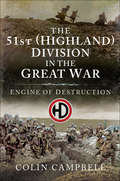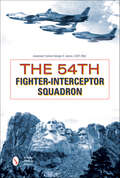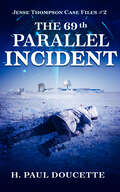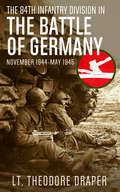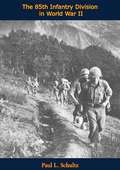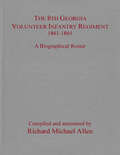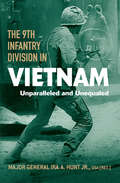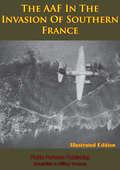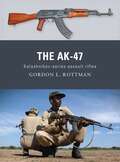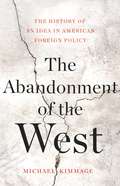- Table View
- List View
The 51st (Highland) Division in the Great War: Engine of Destruction
by Colin CampbellScotland provided two Territorial Force divisions at the outbreak of the First World War, in due course taking their place in the order of battle as the 51st (Highland) Division and the 52nd (Lowland) Division. 1066 and All That concluded that the war was won by the Americans, assisted by the Australians (AZTECS) and some Canadians, and 51 Highlanders. If nothing else, this ironic analysis showed that Major General George (Uncle, sometimes Daddy) Harper was a master of positive publicity and knew its value in building the Divisions image and morale. He commanded the Division from late September 1915 until shortly before the opening of the German Spring Offensive in March 1918, when he was promoted to the command of IV Corps; his name is firmly linked to the 51st.The Division arrived in France in May 1915 and took part in a limited (and unsuccessful) attack in French Flanders in June 1915, which revealed hardly surprising weaknesses in training. The next year was spent relatively quietly on the Somme and, from March 1916, the southern end of Vimy Ridge. Thereafter it fought on the Somme at High Wood and Beaumont-Hamel, at the Battle of Arras, at Third Ypres, Cambrai, faced two of the German spring offensives of 1918 and was then involved in the successful series of allied offensives that ended the war, in the Divisions case starting with an attack with the French and the Italians in the Champagne in July 1918.No history of the Division has been written since Brewshers in 1921. This book aims to cast a more objective light on its activities and to challenge its post war critics. It makes full use of official records and first hand accounts, including those provided by descendants with previously unpublished family records or illustrations. The books main purpose is to pay tribute to a generation that met hitherto unimagined horrors with fortitude, adaptability, resilience and humour and, despite the awful price in lives, broken bodies and minds, carried on until the job was done.
The 54th Fighter-Interceptor Squadron
by George A. LarsonTraces the Cold War defense of North America
The 614th Tank Destroyer Battalion: Fighting on Both Fronts
by Samuel de KorteFinalist, 2022 Army Historical Foundation Distinguished Writing AwardsThe 614th Tank Destroyer Battalion was activated on 25 July 1942 at Camp Carson, USA and, like many other tank destroyer battalions, would be sent to Europe. It saw combat in France, where a platoon earned the Distinguished Unit Citation, and later continued to fight gallantly in Germany and Austria until the war was over. However, unlike many other tank destroyer battalions that fought in the Second World War, this unit was crewed only by black soldiers. The men had been subjected to racism from their countrymen during training, although the battalion did eventually win the respect of the white soldiers they fought alongside. When the third platoon deployed their guns on the slopes near Climbach, France, they weren’t just fighting against the Germans, but also against any prejudices that their white countrymen might have had. Having earned the respect of the 103d Infantry Division, the 614th Tank Destroyer Battalion shared in their triumphs and tragedies. So when the division needed to retreat during a blizzard, or when Task Force Rhine pushed its way across the German plains, or when the division suffered heavy losses at Schillersdorf, the 614th Tank Destroyer Battalion was there with them. Included in this book are lists of medals awarded to the men during the war, as well as a list of casualties and those that served in the unit.
The 69th Parallel Incident: Jesse Thompson Case Files 2 (Jesse Thompson Case Files)
by H. Paul DoucetteLate one night, while tending to his trap-line, a native Inuit stumbles across a clandestine rendezvous not far from one of the DEW line radar sites and is subsequently shot and killed. This incident brings RCMP intelligence officer, Inspector Jesse Thompson to the north. He gradually uncovers a Soviet network involving an agent and a paid mole in the Shingle Point site.
The 7th Georgia Volunteer Infantry Regiment 1861–1865: A Biographical Roster
by Richard Michael AllenThe 7th, 8th, 9th, and 11th Georgia volunteer infantry regiments spent most of the Civil War fighting under Brig. Gen. George Thomas “Tige” Anderson in Gen. Robert E. Lee’s Army of Northern Virginia. Until now, no biographical roster of their members has ever been published. These Georgians saw it all, from the bloody battle of First Manassas through the ferocious combat of Second Manassas, Sharpsburg, Gettysburg, the Wilderness, Spotsylvania, and the long siege of Petersburg. They finally furled their banners at Appomattox. Nearly 5,000 men passed through these four Georgia regiments. These rosters offer a long overdue record of these men. Each roster is organized by company in a simple and easy to use format. Entries feature full names (if known), promotions, demotions, casualties, transfers, and resignations for every rank—an unprecedented look into men and the structure and evolution of these organizations. They include the most comprehensive examination of the personnel originally enlisted and their subsequent service histories within these units in chronological order for the first time. Compiler and author Richard Allen has spent nearly two decades researching scores of archives and other sources to prepare these rosters. He utilized primary sources such as the Official Records, Compiled Service Records, newspaper accounts, diaries, letters, census information, burial records, and a variety of documents from both published sources and private collections. Students of the Civil War, genealogists, and enthusiasts of Georgia history will find these rosters invaluable. Everyone who uses them owes Rick Allen a hearty, and heartfelt, thank you.
The 84th Infantry Division in The Battle of Germany
by Lt. Theodore DraperThe 84th Division in the Battle of Germany, November 1944 – May 1945, first published in 1946, is the account of the combat experiences of the noted “The Railsplitter Division” of the U.S. Army in the later days of World War II. Based on numerous interviews conducted immediately after each movement or encounter with the enemy, the book provides an in-depth look at the experiences of U.S. infantrymen as they moved into Germany in the face of often fierce resistance and muddy and freezing conditions. The Division fought at the Battle of the Bulge, was in the lead to cross the Roer and Rhine Rivers and the taking of the large city of Hannover, quickly followed by the successful crossing of the Elbe River. Along the way, the Division captured more than 70,000 German soldiers, liberated several concentration and internment camps, and met-up with Russian forces advancing from the east to form a critical part of the Allied victory. Included are 18 pages of maps and nearly 80 photographs and illustrations.
The 85th Infantry Division in World War II
by Paul L. SchultzThe 85th Infantry Division also known as "Custer Division", saw much service in the Second World War off of it the bitter Italian campaign in the European Theater of Operations. In this fascinating and detailed account, written by a member of the division itself, the operations, hardships and victories are recounted. Often fighting in difficulty hilly terrain, against prepared positions of great strength or defended river crossings the 85th always advanced to victory even in the most adverse circumstances.
The 8th Georgia Volunteer Infantry Regiment 1861–1865: A Biographical Roster
by Richard Michael AllenThe 7th, 8th, 9th, and 11th Georgia volunteer infantry regiments spent most of the Civil War fighting under Brig. Gen. George Thomas “Tige” Anderson in Gen. Robert E. Lee’s Army of Northern Virginia. Until now, no biographical roster of their members has ever been published. These Georgians saw it all, from the bloody battle of First Manassas through the ferocious combat of Second Manassas, Sharpsburg, Gettysburg, the Wilderness, Spotsylvania, and the long siege of Petersburg. They finally furled their banners at Appomattox. Nearly 5,000 men passed through these four Georgia regiments. These rosters offer a long overdue record of these men. Each roster is organized by company in a simple and easy to use format. Entries feature full names (if known), promotions, demotions, casualties, transfers, and resignations for every rank—an unprecedented look into men and the structure and evolution of these organizations. They include the most comprehensive examination of the personnel originally enlisted and their subsequent service histories within these units in chronological order for the first time. Compiler and author Richard Allen has spent nearly two decades researching scores of archives and other sources to prepare these rosters. He utilized primary sources such as the Official Records, Compiled Service Records, newspaper accounts, diaries, letters, census information, burial records, and a variety of documents from both published sources and private collections. Students of the Civil War, genealogists, and enthusiasts of Georgia history will find these rosters invaluable. Everyone who uses them owes Rick Allen a hearty, and heartfelt, thank you.
The 9/11 Terrorist Attacks (A Day That Changed America)
by Amy MaranvilleOn September 11, 2001, an entire country ground to a halt as terrorists attacked the World Trade Center in New York City, the U.S. Pentagon in Washington D.C., and crashed an airliner near Shanksville, Pennsylvania. Now readers can step back in time to learn what led up to the 9/11 terrorist attacks, how the tragic events unfolded, and the ways in which one devastating day changed America forever.
The 9/11 Terrorist Attacks (A Day That Changed America)
by Amy MaranvilleOn September 11, 2001, an entire country ground to a halt as terrorists attacked the World Trade Center in New York City, the U.S. Pentagon in Washington D.C., and crashed an airliner near Shanksville, Pennsylvania. Now readers can step back in time to learn what led up to the 9/11 terrorist attacks, how the tragic events unfolded, and the ways in which one devastating day changed America forever.
The 9/11 Wars
by Jason BurkeDAILY TELEGRAPH, ECONOMIST AND INDEPENDENT BOOKS OF THE YEARThroughout the 1990s a vast conflict was brewing. The storm broke on September 11th 2001. Since then much of the world has seen invasions, bombings, battles and riots. Hundreds of thousands of people have died. Jason Burke, a first-hand witness of many of the conflict's key moments, has written the definitive account of its course in his acclaimed book The 9/11 Wars.At once investigation, reportage and contemporary history, The 9/11 Wars is an essential book for understanding the dangerous and unstable twenty-first century. Whether reporting on the riots in France or the attack on Mumbai, suicide bombers in Iraq or British troops fighting in Helmand, Jason Burke tells the story of a world that changed forever when the hijacked planes flew out of the brilliant blue sky above Manhattan on September 11th.Reviews:'The best overview of the 9/11 decade so far in print' Economist'A magisterial history of the last decade ... The long patient sentences of The 9/11 Wars are suffused with the melancholy of a man who has learned a great deal from long exposure to atrocity and folly' Pankaj Mishra, Guardian'The 9/11 Wars warrants great respect' Metro'Pacy, well-researched, and packed with telling anecdotes, this book's strength is in its detailed, balanced overview ... At a time when there are more books out on terrorism than ever before ... this is likely to be among the best' Sunday Telegraph'[Burke] is one of the most respected and experienced foreign correspondents in the business ... A major authority on the politics and organisation of Islamic extremism and ... a talented writer with the rare gift of joining effortless prose to challenging scholarship ... [The 9/11 Wars] is a magnificent achievement' Irish Times'A reader wanting a more dispassionate survey of how 9/11, and the response to it, may have shaped parts of the world will do no better than invest in [this] brilliant book' David Aaronovitch, The Times'This remarkably balanced, well-sourced and very well-written book ... will be turned to in the future ... [Burke] has demonstrated impressive expertise as a historian who has had the advantage of having been present on many of the battlefields he describes' Andrew Roberts, Evening Standard'[A] lucid, sane account ... taut, careful reporting ... Remarkable' Scotsman'Potent ... journalism of a high order. Like all good reporters, Burke is something of a scholar, drawing meticulously on interview notes years old, and on extensive background reading. He excels, too, in describing the experiences of ordinary Muslims; such insights make this book essential for understanding the past decade' Sunday TimesAbout the author:Jason Burke is the South Asia correspondent for the Guardian. He has reported around the world for both the Guardian and the Observer. He is the author of two other widely praised books, both published by Penguin: Al-Qaeda and On the Road to Kandahar. He lives in New Delhi.
The 91st Infantry Division in World War II (Divisional Ser. #Vol. 49)
by Robert A. RobbinsOriginally published in 1947 by Infantry Journal Press, this is the official unit history for the 91st Infantry Division in World War II. The 91st Infantry Division arrived in North Africa, 18 April to 10 May 1944, and trained intensively at Arzew and Renan, French Morocco. Leaving by units, the entire Division was in Italy, 19 June 1944. Meanwhile, the 361st RCT landed at Anzio, 1 June, and fought near Velletri south of Rome from 3 June. The 363d RCT entered combat near Riparbella, 4 July. On 12 July, the Division fought as a unit near Chianni, Italy, for the high ground dominating the Arno River. By the 19th it had reached the river. The 363d RCT participated in the capture of Livorno, 19 July, and in a quick thrust to the north, two units entered Pisa, 24 July. From 24 July to 12 September 1944, the 91st held their positions along the Arno while they underwent extensive training. On the 13th, the Division attacked the Gothic Line, took Monticelli, 18 September, and advanced to the Santerno River through stubborn resistance, 23 September. Moving through rocky escarpments and other natural barriers as well as heavy opposition, the 91st occupied Livergnano, 13 October. The offensive was canceled, however, and the 91st assumed defensive positions below Pianoro, 31 October. During November, the 91st remained on the defensive, sending out small patrols. After resting in December, the Division returned to the line and maintained a static defensive front until 20 March 1945, when the Division retired to Gagliano and Villanova to prepare for a new offensive. This final assault began on 15 April 1945. The 91st entered Bologna, 21 April, and moved along Highway No. 64 against slight resistance. After crossing the Po River on the 23d, the Division swung to the northeast, crossing the Adige River, 26 April, and reaching. Treviso on the 29th. All enemy forces in Italy surrendered, 2 May... General Nickname: Powder River Division. Slogan: Always Ready—Print ed.
The 9th Australian Division Versus The Africa Corps: [Illustrated Edition]
by Colonel Ward MillerIllustrated with 7 maps and 15 photosIn April and May 1941, the previously successful blitzkrieg tactics of the German Army met defeat by the outnumbered Australian forces of the 9th Division at Tobruk. The Australian infantry achieved victory through a successful all-around defense against tank attacks in force. By employing all available assets in a combined arms effort, well-supported light infantry forces defeated a heavier armored force.The 9th Australian Division Versus the Africa Corps: An Infantry Division Against Tanks-Tobruk, Libya, 1941 provides the reader with a valuable historical context for evaluating how light infantry forces can confront armored attacks. This CSI special study also reveals how light infantry forces operated and were supported and sustained in a desert environment-a message that has continuing relevance for today's Army.
The 9th Georgia Volunteer Infantry Regiment 1861–1865: A Biographical Roster
by Richard Michael AllenThe 7th, 8th, 9th, and 11th Georgia volunteer infantry regiments spent most of the Civil War fighting under Brig. Gen. George Thomas “Tige” Anderson in Gen. Robert E. Lee’s Army of Northern Virginia. Until now, no biographical roster of their members has ever been published. These Georgians saw it all, from the bloody battle of First Manassas through the ferocious combat of Second Manassas, Sharpsburg, Gettysburg, the Wilderness, Spotsylvania, and the long siege of Petersburg. They finally furled their banners at Appomattox. Nearly 5,000 men passed through these four Georgia regiments. These rosters offer a long overdue record of these men. Each roster is organized by company in a simple and easy to use format. Entries feature full names (if known), promotions, demotions, casualties, transfers, and resignations for every rank—an unprecedented look into men and the structure and evolution of these organizations. They include the most comprehensive examination of the personnel originally enlisted and their subsequent service histories within these units in chronological order for the first time. Compiler and author Richard Allen has spent nearly two decades researching scores of archives and other sources to prepare these rosters. He utilized primary sources such as the Official Records, Compiled Service Records, newspaper accounts, diaries, letters, census information, burial records, and a variety of documents from both published sources and private collections. Students of the Civil War, genealogists, and enthusiasts of Georgia history will find these rosters invaluable. Everyone who uses them owes Rick Allen a hearty, and heartfelt, thank you.
The 9th Infantry Division in Vietnam: Unparalleled and Unequaled (American Warriors Series)
by Major General Ira A. Hunt Jr.&“This outstanding book is a must read for those trying to understand the Vietnam War and its guerrilla warfare tactics&”—from the author of Losing Vietnam (Post Library). Of all the military assignments in Vietnam, perhaps none was more challenging than the defense of the Mekong River Delta region. Operating deep within the Viet Cong-controlled Delta, the 9th Infantry Division of the U.S. Army was charged with protecting the area and its population against Communist insurgents and ensuring the success of the South Vietnamese government&’s pacification program. Faced with unrelenting physical hardships, a tenacious enemy, and the region&’s rugged terrain, the 9th Division established strategies and quantifiable goals for completing their mission, effectively writing a blueprint for combating guerilla warfare that influenced army tacticians for decades to come. In The 9th Infantry Division in Vietnam, Ira A. Hunt Jr. details the innovative strategies of the 9th Division in their fight to overcome the Viet Cong. Based on Hunt&’s experience as colonel and division chief of staff, the volume documents how the 9th Division&’s combat effectiveness peaked in 1969. A wealth of illustrative material, including photos, maps, charts, and tables, deepens understanding of the region&’s hazardous environment and clarifies the circumstances of the division&’s failures and successes. A welcome addition to scholarship on the Vietnam War, The 9th Infantry Division in Vietnam will find an audience with enthusiasts and scholars of military history. &“General Hunt set about proving that the claims of the 9th Infantry Division&’s brilliant performance in Vietnam were founded on fact. He succeeded and far more.&”—Jack N. Merritt, General, U.S. Army, Retired
The A.E.F. Of A Conscientious Subaltern [Illustrated Edition]
by Major-General Hanford MacniderA Short but very valuable memoir from a future General of the American Army who faced his first baptism of first in the trenches of the First World War. Includes a number of sketches of the men with whom he served and the frontline."Memoir, 1917-1918. MacNider was a lieutenant in the 9th Infantry Regiment, 2nd Division. This short memoir provides vignettes of fighting near Soissons and St. Mihiel."- p. 232, Edward Lengel, World War I Memories, 2004, The Scarecrow Press, Lanham Maryland, Toronto, Oxford.
The AAF In Northwest Africa [Illustrated Edition] (Wings At War #6)
by AnonThe AAF in Northwest Africa focuses on the Allied assault on Northwest Africa and the battle for Tunisia-the critical second front that secured the Mediterranean and increased the enemy's vulnerability to a massive invasion from Britain. From this experience of the Twelfth Air Force and its British counterparts in 1942-43 evolved a spirit of Anglo-American cooperation and important aspects of air doctrine still relevant to today's Air Force.Originally published shortly after key air campaigns, the Wings at War series captures the spirit and tone of America's World War II experience. Eyewitness accounts of Army Air Forces' aviators and details from the official histories enliven the story behind each of six important AAF operations.
The AAF In The Invasion Of Southern France [Illustrated Edition] (Wings At War #1)
by AnonIllustrated with 6 maps and 11 Illustrations.The AAF in the Invasion of Southern France tells how the Mediterranean Allied Air Forces, under the command of Lt. Gen. Ira Eaker, supported the Allied airborne and amphibious assault designed to undercut German defenses in Occupied France. In this invasion-the fourth major one in three months-American air power overwhelmed the meager enemy forces and diverted attention from the north, helping to topple German control in Vichy. Air operations persistently found, fixed, and fought occupying German forces, preventing their orderly withdrawal, greatly easing the way for Allied invasion forces.Originally published shortly after key air campaigns, the Wings at War series captures the spirit and tone of America's World War II experience. Eyewitness accounts of Army Air Forces' aviators and details from the official histories enliven the story behind each of six important AAF operations.
The AI Wave in Defence Innovation: Assessing Military Artificial Intelligence Strategies, Capabilities, and Trajectories
by Michael RaskaAn international and interdisciplinary perspective on the adoption and governance of artificial intelligence (AI) and machine learning (ML) in defence and military innovation by major and middle powers. Advancements in AI and ML pose pressing questions related to evolving conceptions of military power, compliance with international humanitarian law, peace promotion, strategic stability, arms control, future operational environments, and technology races. To navigate the breadth of this AI and international security agenda, the contributors to this book include experts on AI, technology governance, and defence innovation to assess military AI strategic perspectives from major and middle AI powers alike. These include views of how the United States, China, Japan, South Korea, the European Union, and Russia see AI/ML as a technology with the potential to reshape military affairs and power structures in the broader international system. This diverse set of views aims to help elucidate key similarities and differences between AI powers in the evolving strategic context. A valuable read for scholars of security studies, public policy, and STS studies with an interest in the impacts of AI and ML technologies.
The AK-47
by Gordon Rottman Johnny ShumateThe Kalashnikov AK-47 is the most ubiquitous assault rifle in the world, with more AK-47s and its variants in use than any other individual small arm. Created by Senior Sergeant Mikhail Kalashnikov, and first adopted by the USSR soon after World War II, its production continues to this day, with an estimated 75 million produced worldwide. It is the longest serving post-World War II military weapon and its ease of use, durability and low production costs ensure that it's use will continue for generations to come. This book takes a look at the complete history of the weapon, discussing its design, development, and usage, taking its story from the great armies of the Soviet Union to the insurgents and criminal gangs that often employ the weapon today.From the Trade Paperback edition.
The ASVAB (Test Easy)
by Laura Stradley Robin KavanaghRest Easy with Test Easy!You're excited about your decision to join the U.S. Armed Forces, and you know that your ASVAB scores will determine the course of your military career, so you want to do your absolute best. Well, rest easy because Test Easy makes acing your exam a snap! In this book, you get:A quick assessment to see where you need the most helpStudy strategies to help you do your very bestMath and Science tutorials to get you ready for the Arithmetic Reasoning, Mathematics Knowledge, and General Science categoriesCommunication tutorials to get you ready for the Paragraph Comprehension and Word Knowledge categoriesTechnical tutorials to get you ready for the Assembling Objects, Auto & Shop, Electronics, and Mechanical Comprehension categories3 full Armed Services Vocational Battery (ASVAB) practice tests1 full practice Armed Forces Qualifying Test (AFQT)Specific tips to get you ready for each of the 9 categories
The Abandonment of the West: The History of an Idea in American Foreign Policy
by Michael KimmageThis definitive portrait of American diplomacy reveals how the concept of the West drove twentieth-century foreign policy, how it fell from favor, and why it is worth saving.Throughout the twentieth century, many Americans saw themselves as part of Western civilization, and Western ideals of liberty and self-government guided American diplomacy. But today, other ideas fill this role: on one side, a technocratic "liberal international order," and on the other, the illiberal nationalism of "America First."In The Abandonment of the West, historian Michael Kimmage shows how the West became the dominant idea in US foreign policy in the first half of the twentieth century -- and how that consensus has unraveled. We must revive the West, he argues, to counter authoritarian challenges from Russia and China. This is an urgent portrait of modern America's complicated origins, its emergence as a superpower, and the crossroads at which it now stands.
